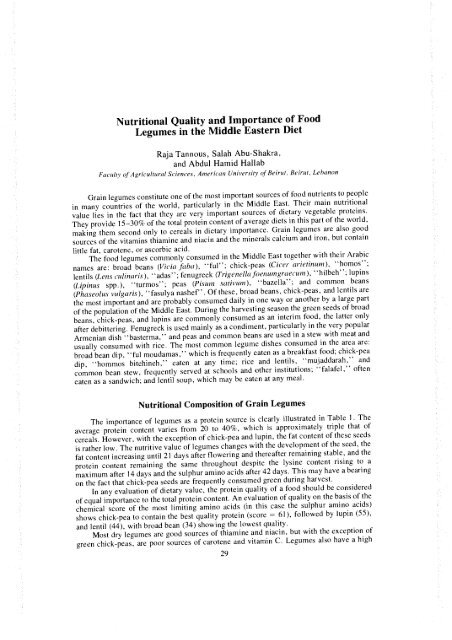I ARCHIV - International Development Research Centre
I ARCHIV - International Development Research Centre
I ARCHIV - International Development Research Centre
- No tags were found...
Create successful ePaper yourself
Turn your PDF publications into a flip-book with our unique Google optimized e-Paper software.
Nutritional Quality and Importance of Food<br />
Legumes in the Middle Eastern Diet<br />
Raja Tannous, Salah Abu-Shakra,<br />
and Abdul Hamid Hallab<br />
Faculty of Agricultural Sciences, American University of Beirut, Beirut, Lebanon<br />
Grain legumes constitute one of the most important sources of food nutrients to people<br />
in many countries of the world, particularly in the Middle East. Their main nutritional<br />
value lies in the fact that they are very important sources of dietary vegetable proteins.<br />
They provide 15-30% of the total protein content of average diets in this part of the world,<br />
making them second only to cereals in dietary importance. Grain legumes are also good<br />
sources of the vitamins thiamine and niacin and the minerals calcium and iron, but contain<br />
little fat, carotene, or ascorbic acid.<br />
The food legumes commonly consumed in the Middle East together with their Arabic<br />
names are: broad beans (Vicia faba), "ful"; chick-peas (Cicer arietinurn), "homos";<br />
lentils lLens culinaris), "adas"; fenugreek (Trigenella foenumgraecum), "hilbeh''; lupins<br />
tLipinus spp.), "turmos"; peas (Pisuin sativum), "bazella"; and common beans<br />
(Phaseolus vulgaris), "fasulya nashef". Of these, broad beans, chick-peas, and lentils are<br />
the most important and are probably consumed daily in one way or another by a large part<br />
of the population of the Middle East. During the harvesting season the green seeds of broad<br />
beans, chick-peas, and lupins are commonly consumed as an interim food, the latter only<br />
after debittering. Fenugreek is used mainly as a condiment, particularly in the very popular<br />
Armenian dish "basterma," and peas and common beans are used in a stew with meat and<br />
usually consumed with rice. The most common legume dishes consumed in the area are:<br />
broad bean dip, 'ful moudamas,'' which is frequently eaten as a breakfast food; chick-pea<br />
dip, "hommos bitehineh," eaten at any time; rice and lentils, "mujaddarah," and<br />
common bean stew, frequently served at schools and other institutions; "falafel," often<br />
eaten as a sandwich; and lentil soup, which may be eaten at any meal.<br />
Nutritional Composition of Grain Legumes<br />
The importance of legumes as a protein source is clearly illustrated in Table I. The<br />
average protein content varies from 20 to 40%, which is approximately triple that of<br />
cereals. However, with the exception of chick-pea and lupin, the fat content of these seeds<br />
is rather low. The nutritive value of legumes changes<br />
with the development of the seed, the<br />
fat content increasing until 21 days after flowering and thereafter remaining stable, and the<br />
protein content remaining the same throughout despite the lysine content rising to a<br />
maximum after 14 days and the sulphur amino acids after 42 days. This may have a bearing<br />
on the fact that chick-pea seeds are frequently consumed green during harvest.<br />
In any evaluation of dietary value, the protein quality of a food should be considered<br />
of equal importance to the total protein content. An evaluation of quality on the basis of the<br />
chemical score of the most limiting amino acids (in this case the sulphur amino acids)<br />
shows chick-pea to contain the best quality protein (score = 61), followed by lupin (55),<br />
and lentil (44), with broad bean (34) showing the lowest quality.<br />
Most dry legumes are good sources of thiamine and niacin, but with the exception of<br />
green chick-peas, are poor sources of carotene and vitamin C. Legumes also have a high<br />
29

















